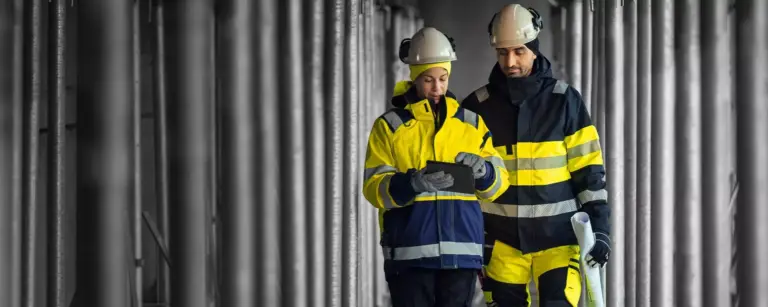Learn the Who, What and Where of AWP Execution
Advanced Work Packaging (AWP) represents the next big shift in construction project management. Owner organizations and contractors alike are beginning to realize increased predictability, improved productivity and significant cost savings from working within an AWP framework.
This webinar breaks down the fundamentals the AWP methodology and examines the many benefits of Advanced Work Packaging.
Originally aired on 4/8/20
25 Minutes
Transcript
John Klobucar:
Hello, I’m John Klobucar with InEight and I’d like to welcome you to the latest webcast at our Path of Construction series. Today’s webcast is titled “Learn the Who, What and Where of AWP Execution.” Our presenter today is AJ Waters who is a Director of Industry Solutions at InEight. In this role, AJ leads a team of engineers who engage with InEight customers to help them find innovative ways technology can be used to achieve predictable outcomes, improve project performance and minimize risks.
John Klobucar:
Now if you have any questions as you watch this webcast, please email them to webcasts@ineight.com and AJ will do his best to answer them. Also, this presentation is being recorded and we’ll be sending you a link to the video in about a week’s time. Once again, we’re glad you’ve joined us and now let me introduce AJ Waters.
AJ Waters:
Thank you, John. And welcome to our webinar today. We are talking about today “Learning the Who, What and Where of Advanced Work Packaging Execution.” And really this is the sixth webinar in our Best Path of Construction series here at InEight, so if you haven’t caught up on the first five, be sure to visit InEight.com and visit our a webinars tab and you can catch up on how we got here and what exactly we’ve been discussing through this Best Path of Construction.
AJ Waters:
But we’re going to jump into, now that all this planning is done and we’re ready to go build the work, what has InEight done and what are we doing to help that out? But first and foremost, one of the things I like to talk about is, why? Why does it matter that we’re talking about the Best Path to Construction? Why does it matter that we’re talking about how to best move toward execution of a plan? And really it goes back to the old adage of poor planning equals poor performance. And I’ve got a great example, a chance to make fun of myself a little bit here with some work that I did recently in my own home.
AJ Waters:
So let’s set the stage first and foremost. This is essentially like retrofitting a project that you have in place, the house exists, I’m not building it, but I’m utilizing parts that are already there, in a sense, and I’m trying to enhance or make that better. And what we’re going to do is we were looking to build a home theater, and the basement was already wired for the surround sound, it was set up perfectly with a focal point wall. We thought we had everything exactly the way we wanted it. And then work began and we ran into some missing pieces. First and foremost, the surround sound that we ordered didn’t really work with that wiring that was already in the house. You can see that the modernized plugs for the audio cables did not really line up with the two-pronged approach of the wiring. So I anticipated this one and ordered some adapters that were built for that. And so ideally, you’d plug the two ends of the wire into the red and silver of the adapter and then you’d plug that adapter into the speakers and everything would work out.
AJ Waters:
The problem was either those speaker wires no longer worked, they were in the house when we bought it and they no longer worked or the gauge of the wire was too much for those adapters. So in the end, we ended up having to run wiring along the ceiling, which wasn’t necessarily ideal, but it does the job. And luckily, I had some of this wiring laying around from an old sound system that we had that we weren’t using anymore. And so that is a day on the schedule of having to test and retest and rework, and it was a lot of fun.
AJ Waters:
But it doesn’t end there because the procurement process is just one piece that we’re trying to solve with Advanced Work Packaging. Another key piece that we’re trying to solve with Advanced Work Packaging is the engineering process and sometimes the lack of coordination. And one of the things that I happened to miss was this projector that we ordered, it was a short throw projector so it could sit on the entertainment center right in front of the wall. I wouldn’t have to hang one. I thought I could save time by not having to install an arm to hang a projector from the ceiling and wire an outlet into the ceiling. And instead, what I ended up with is a picture on the ceiling. You can see there that the projection screen is shooting up all the way onto the roof because the entertainment center was too high and we had a lack of coordination. We had to go out and get a different entertainment center and install that so that we could get the projector down low enough that we could hang the screen in the right spot. So not only did we have procurement issues, but we had some design issues. But what really went wrong? Why did the home theater go bad?
AJ Waters:
Well, first and foremost, when we talk about the issues we had with procurement, this was the first piece that showed up, the adaptor for the speaker wires was the first thing that arrived, not the sound system itself, not the projector. The first thing that arrived was the adaptor for the wire, so then we had to wait. Conversely, the last thing that arrived was the actual screen. So aligning the soundbar on the wall where it needed to be, knowing that the projector had to be lower than our current entertainment center was going to allow for it, none of that was available information because the screen was the last thing to arrive. We had coordination issues because there was a lack of a finished design. Once the projector finally arrived, this table was in the manual telling you how to align the projector with the screen as far as height and distance, and this is when we first started to realize that our entertainment center was going to be too high once the projector showed up. Everything was already ordered, we were waiting for different pieces to arrive and we found out then that we needed to order yet another piece.
AJ Waters:
All of that resulted in a project, an in-home project, that came in about 10% over budget and 100% late. It took double the time to do than we expected it to, again, because of issues waiting for that screen to arrive. It took a lot longer to show up than we thought it would. And then having to order a part after the fact, after the design was done. And really that’s what we’re talking about when it comes to Advanced Work Packaging is how can InEight’s concept of this Best Path to Construction and Advanced Work Packaging simplify solutions like that. And the first thing that it’s going to work to simplify is knowing when it’s the right time to actually begin the work so I’m not sitting there with a projector pointed at the ceiling because I started too soon on the work. I don’t have all of my constraints removed.
AJ Waters:
It helps to effectively communicate that plan to the field, specifically the plan that aligns the projector with the screen. Where exactly do things need to be set? Do I have blockades in place that are going to cause me issues? One of the things that Advanced Work Packaging does from InEight is it utilizes mobility as a key to all of this work, and so we’ll take a look at that. And then finally, incorporating real-time analytics into adjusting the plan. So for the future, I know that my procurement’s going to be off or I know what the long lead item is that I can order weeks in advance before I order other parts and adjusting that for future plans that we’re going to a build. So this is what we’re going to walk through today quickly and how InEight has solved these items through Advanced Work Packaging. So let’s dive right in.
AJ Waters:
First and foremost, the number one thing that you want to do when it comes to Advanced Work Packaging is you don’t want to start work that you’re not ready to begin, work that you can’t finish, because the number one killer of efficiency is stopping the operation and having to start it again. And so taking a break in the operation. So just a refresher, if you haven’t seen the rest of the Best Path of Construction webinars, the idea of a Best Path of Construction is that high level sequence of activities that establish your optimal building path. So it’s a high level sequence, but it puts together the framework and the target of which the rest of the project is going to be built around the engineering, the procurement, all the way down to the execution. And by doing that, by using that Best Path of Construction process, you inherently accommodate those need by dates and you build with constraints in mind, allowing yourself to know when you can begin work on items that are significant. So that’s the overall goal of the Best Path of Construction. And those constraints make their way all the way down to execution and knowing when it’s the right time to begin work.
AJ Waters:
And that happens by taking those construction work packages that you’ve developed at a high level and breaking them down into IWPs, installation work packages, for the true in-field workface plan. These IWPs are built 90 days prior to the scheduled date for that operation. So take the CWP, the construction work package, and break it down into multiple IWPs around that 90-day mark. And you build them as duration based checklists from which your daily plans are going to originate. So it’s essentially your three-week look ahead, and we’ll see that here in a bit. But you build these as a duration-based checklist of things to do. And IWPs are then the culmination of the Advanced Work Packaging workflow, bringing together all of your third parties into a fully data-enriched operation. And so you get all of your engineering, all of your procurement, all of your construction, all in one place. And that’s what leads you to constraint for your work. An IWP should only be released to the field once they’re constraint-free.
AJ Waters:
Now, one of the questions you might be asking is what are constraints? Well, a lot of times construction looks at constraints like having enough resources. Like “I don’t have enough people to get this operation done. We’re sliding in our schedule.” And those are typically easy to fix, just throw more people at the operation. You can get it done faster with more bodies. But the constraints that we’re after when it comes to Advanced Work Packaging are the ones that are difficult to solve like missing material, like an operation not being able to commence because there’s something in the way or a lack of coordination. What doing this constraint management and building these IWPs does for execution is it forces a project to pay more attention to hidden or less understood critical paths and therefore, it’s not obvious to go start work unless these open constraints are taken care of. And so the first thing when it comes to the who, what and where of execution is to make sure that you are constraint-free.
AJ Waters:
Once you’re constraint-free, then you got to collect all of this information that you’ve built to date and you’ve got to communicate that out to the field. So, what are some of the things that the foreman needs to go execute the work? Well, that’s things like the plot plans or the drawings, the scope of work, maybe there are risks or assumptions that you want to include, maybe the operation has moved forward and there’s progress or status on certain pieces that needs to be included. Of course, the constraint list is a big deal. If any of those are open, they’re definitely going to want to know it. But ideally they’ve got a list that’s checked off. And equipment, what they need to install, the items. That’s probably important. And finally, the list of the individual components that they are going to be working on for that particular plan. And there could be more that you would include, there could be less, but these are the types of things that we’re talking about communicating to the field and putting together when we talk about collecting the IWPs.
AJ Waters:
You can then take that information and put that into a short interval planning system or a three-week look ahead. And what InEight has done is they have integrated the bottom-up planning and the top-down planning in one place using what we call SIP, or short-interval planning. It inherits the CPM schedule outline, which are those CWPs, and allows you to disseminate that down into your IWPs and then down into those daily crew levels. And most importantly, it allows you to validate the over or under-allocation of your crews on the project. Can they truly get this much done or not? Do I have them working in too many places at once? Do I have this piece of equipment in more than one place at a time? The allocation of your resources on the project are key to understanding, collecting and then sending that plan out to the field. That allows your teams to build the right thing at the right time, they know exactly where they need to be and they know exactly what they need to do today.
AJ Waters:
Consolidate all those details down utilizing our progress application to tell you exactly the tasks that you’re going to work on and any safety, quality or environmental risks that might be involved, exactly the crew and the equipment that are going to work on those tasks, how long they should spend on them, and exactly what they should get done as far as quantities are concerned. So taking all of that information, deriving it down to what should be accomplished today and allowing your crews to go execute knowing exactly what steps, exactly which place, and exactly how they are going to build the work. That is a key to Advanced Work Packaging execution.
AJ Waters:
And why did InEight focus on mobility as the driver and the delivery vehicle for those plans? Well, it begins with having the information available at the operation. It’s Advanced Work Packaging on the go with the crew in mind. Your information is available where the operation is happening, not at a kiosk, not back in the trailer, but exactly where the crew is doing the work. And that allows for more time on tools. It eliminates any manual paper processes, or workflows, or movement back to the office or that kiosk, or a screen somewhere because it’s all available on the device sitting right there in your hands. And that streamlines the planning and execution into a single-user experience that is available across all the devices.
AJ Waters:
Why is it important to simplify the user experience? Well, it really comes down to following principles that brought mobility to the mainstream. If you think about today’s mobile devices, you can hand one to anyone of any age of any background and they inherently can start swiping and moving and navigating the device. And it really comes down to building applications that work like the applications you use in your everyday life, with the buttons, with the layovers, with the help, everything that you’re used to pulling out of your pocket on a daily basis that is what we want to do to simplify the work in the field. Why make them learn some new way to use a special device when the device that they’ve become most accustomed to is the one that’s in their pocket and they already know how to navigate?
AJ Waters:
And the final key in using mobility is that a picture’s worth a thousand words. When it comes to using mobile devices, the camera is with you all the time. So whether it’s a note, it’s an issue, it’s a progress claim, it’s an inspection that you’re completing, there’s always the ability to add a photo and say that extra thousand words without having to type it all in or explain what just happened. And so that’s why our focal point here at InEight with Advanced Work Packaging execution came down to building it with a simplified user experience on a mobile device.
AJ Waters:
Now, all of this is only as good as what you can do with it. All of this data is only as good as the feedback and the adjustments that you get from it. And that’s where real-time analytics come into play. When you integrate things like the quantities and the time into a single application, you get what you need when you need it. Like crude productivity against the goals for those tasks that week. They happen in application. You know exactly when you submit your information, whether you’ve finished on time or on budget. And because of that you don’t have to wait to aggregate all that data into one place to make adjustments to the plan. You know exactly what happened that day, you know where you’re at and you know what that means for you going forward and you can make those slides or those adjustments, you can add the resources, you can handle the constraints that are easy to handle because you’ve eliminated all of the constraints that are difficult and you can make your adjustments. And those adjustments lead to proactive, intelligent, or educated decisions. A daily review of this progress allows for immediate action.
AJ Waters:
And it’s your information your way in the InEight system, customizable dashboards, metrics, charts. What is important to you is what you see. And you see it all in one screen, blending vast amounts of data from multiple sources, no longer do you have to try to pull different Excel sheets together or make graphs or charts out of numerous wall charts. It’s all pulled together in one place and, as we mentioned before, the automatic closed loop for feedback for planning in the future because what you learn today will be beneficial to you the next time you build something similar and it will allow you to understand what my risks are, where my bottlenecks are in the procurement process and plan accordingly on that next project.
AJ Waters:
So let’s recap that all real quick. InEight’s Advanced Work Packaging solution is designed as a new way to simplify and intuitively help you know when it’s right to start the work. When you are constraint-free and you can walk up to an operation, you can start it and you don’t have to stop until you’re done. It gives you a simplified way to collect all the planning that you’ve done up front and communicate that to the field, and communicate it in a way that they understand using mobility, using the user interfaces that they are accustomed to, and allowing them to do things like take pictures and provide feedback with all of the power of those mobile devices. And again, it takes all of that that you’ve collected, all of this planning, all this execution and it puts that together into a real-time dashboard to give you feedback on your plan, to give you ways to make adjustments right then and there, and to allow you to improve your efficiencies and keep that project on track and on budget all the way to the end.
AJ Waters:
So I want to thank you for joining us today on this journey through the who, what and where of Advanced Work Packaging execution. Be sure to check out our upcoming webinars to finish out our Best Path of Construction series, including next, a deep dive on the short interval planning that we just briefly touched on today. Have a great day.
John Klobucar:
Thanks AJ. Again, if you have any questions, please email them to webcasts@InEight.com. To learn more about InEight, as well as our digital tools that ensure you build your best work every time, visit InEight.com and click on the “Request a Demo” button. And if you’d like to see a schedule of upcoming events, visit InEight.com/webcasts. Thanks for watching. This concludes our presentation.




